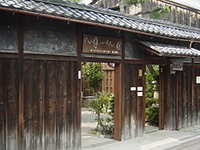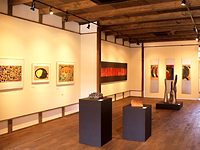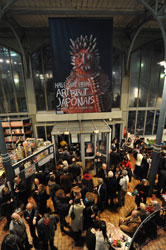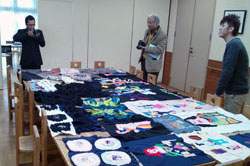- Home
- > About NO-MA
The Uniqueness of NO-MA
 The Borderless Art Museum NO-MA was opened in June, 2004. It is located in an area of preserved historical buildings in Omi-Hachiman City, Shiga Prefecture. The venue is a converted dwelling from the early Showa period and utilizes a
The Borderless Art Museum NO-MA was opened in June, 2004. It is located in an area of preserved historical buildings in Omi-Hachiman City, Shiga Prefecture. The venue is a converted dwelling from the early Showa period and utilizes a
traditional Japanese building and a surrounding traditional warehouse for exhibition purposes. It is operated by Social Welfare Organization Glow (formerly the Shiga-Prefectural Social Welfare Organization). It is a one of a kind museum found here in Japan.
Our strength lies in exhibiting works by persons with disabilities along with works of art created by able-bodied
persons. Through this we believe that visitors will feel the universality of human creativity in a very real way. By doing so, we boldly remove any notion of ‘borders’ between the able-bodied and disabled of the world.
The Birth of NO-MA

The welfare institutions of Shiga Prefecture have a long-standing history of promoting the creativity of persons with
disabilities. This is culminated in a Prefecture-wide debate on the increasing need for a place to exhibit these creations. An enterprise was established to provide a space to serve this need. A vacant 80 year-old traditional town house, in the preserved historical buildings area of Omi-Hachiman city, was chosen. Known as ‘Nomatei’, the example of a traditional Japanese architectural form, was to be transformed into this museum as we know and love it today. This is thanks to the input of an artistic community, social welfare workers, academics, and the local populace. The façade of ‘Nomatei’ was left intact while the ground floor was converted into the main exhibition space. The first floor was renovated into a library and exhibition space retaining its strong traditional Japanese characteristics. A space, blending new art with Japanese classical tradition, was born. The name, NO-MA, was taken from the family name of the owners of the building. The name “Noma” comes from the family name ‘Nomatei’. The term ‘borderless’ is a nod to our strongly held beliefs in creating a space where culture and social welfare meet. It is where art and city-planning collide and where any differentiation between the able-bodied and disabled are meaningless.
Initially, NO-MA was established as the ‘Borderless Art Gallery NO-MA’ and operated by the Social Welfare Corporation,
and the Shiga-Prefectural Social Welfare Organization (Social Welfare Organization Glow). In the spring of 2007, however, we
were granted the status of being a ‘museum’ by the local government and have ever since been known as the ‘Borderless
Art Museum NO-MA’.
Overseas Collaborative Projects
 We have been collaborating with the Collection de l’Art Brut in Lausanne, Switzerland since 2006 . In 2008 the joint exhibition “JAPON” was realized. Also in 2008, we further collaborated on the ‘Art Brut, Crossing Spirit’ which toured Tokyo, Hokkaido and Shiga in Japan. We were finally able to give Japanese art brut exposure. It was after this, when the ‘JAPON’ exhibit was in Switzerland, that the works on display caught the attention of the director of the Halle Saint Pierre Museum in Paris. The director approached us, resulting in another collaboration. This brought 800 pieces of work by 63 Japanese artists to Paris. (Note: Out of the 63 artists, 18 were from Shiga prefecture)
We have been collaborating with the Collection de l’Art Brut in Lausanne, Switzerland since 2006 . In 2008 the joint exhibition “JAPON” was realized. Also in 2008, we further collaborated on the ‘Art Brut, Crossing Spirit’ which toured Tokyo, Hokkaido and Shiga in Japan. We were finally able to give Japanese art brut exposure. It was after this, when the ‘JAPON’ exhibit was in Switzerland, that the works on display caught the attention of the director of the Halle Saint Pierre Museum in Paris. The director approached us, resulting in another collaboration. This brought 800 pieces of work by 63 Japanese artists to Paris. (Note: Out of the 63 artists, 18 were from Shiga prefecture)
The exhibition was held from March 24, 2010 to January 2, 2011.
These art works from Japan proved to be very popular. An exhibition tour in Japan was carried out as well. Media attention on art brut in Japan increased. There is now great interest in this very particular cross-over of disciplines, art, social welfare and medical care, all of which we cover.
photo by Nobuo Onishi
RESEARCH AND STUDY
 With assistance from the Japanese Welfare and Medical Service Agency, NO-MA undertook a 4 year long (2006-2010) project researching and studying works of art made by persons with disabilities. Up to today, this has totaled 103 artists from across the whole of Japan. The criteria of this initiative was to look for ‘works of art made by persons with disabilities’. Many of the works, however, were found to be regarded as stellar examples of art brut. They were, therefore, included in the aforementioned ‘Art Brut Japonais’ exhibit held in France in 2010. Out of the 63 artists exhibited there, 31 were artists ‘discovered’ via this undertaking. As of 2011, further research and study into the works of art made by persons with disabilities across Shiga prefecture and Japan has been taking place. This time, however, the Shiga Prefecture Art Brut Furtherance Project, has been taking the helm of this initiative: ‘Nation-wide, as well as through out the Asia region, art work research and study’ has been taking place. This includes our neighboring country, Taiwan. Our research is definitely going international.
With assistance from the Japanese Welfare and Medical Service Agency, NO-MA undertook a 4 year long (2006-2010) project researching and studying works of art made by persons with disabilities. Up to today, this has totaled 103 artists from across the whole of Japan. The criteria of this initiative was to look for ‘works of art made by persons with disabilities’. Many of the works, however, were found to be regarded as stellar examples of art brut. They were, therefore, included in the aforementioned ‘Art Brut Japonais’ exhibit held in France in 2010. Out of the 63 artists exhibited there, 31 were artists ‘discovered’ via this undertaking. As of 2011, further research and study into the works of art made by persons with disabilities across Shiga prefecture and Japan has been taking place. This time, however, the Shiga Prefecture Art Brut Furtherance Project, has been taking the helm of this initiative: ‘Nation-wide, as well as through out the Asia region, art work research and study’ has been taking place. This includes our neighboring country, Taiwan. Our research is definitely going international.
This research and study programs were made possible by the kind support and wide network of people across not only Shiga Prefecture and Japan, but also from overseas. They have provided us with invaluable information in regards to the works of art and artists we are searching for. Touted as ‘The Beauty of Shiga’, we continue to cooperate closely with Shiga Prefecture in our quest to find local and indigenous forms of beauty.
We are also doing more than looking for new artists. We are creating a database of all of our research results in the form of reports which will be utilized in future exhibitions. This will be done to disseminate the works and to give as many of the artists discovered, a wide a scope as possible for exposure. We also aim to create a network of persons found through our efforts of research and study initiative.
Research is undertaken by the Art Director of NO-MA, social welfare workers , as well as members of the art gallery and museum world.
SHIGA PREFECTURE, NO-MA AND ART BRUT
Shiga Prefecture has a long-standing history of fostering the creativity of persons with disabilities. It was just after the Second World War where clay-based art activities started at the local Omi Gakuen School. This was led by notable figures, such as Mr. Kazuo Itoga, Mr. Ichiji Tamura, and Mr. Taro Ikeda. They are known as the founding fathers of welfare for the disabled in Japan.
“These children are the light of the world” is the well known epitaph of Kazuo Itoga. He was referring to the new possibilities of making the world a better place. He felt that it was important to live and to learn from what persons with disabilities can show us. That is their ‘light’ that he refers to. The artistic activities and philosophy, which began at the Omi Gakuen School, has been passed onto many social welfare facilities across Shiga Prefecture. With the involvement of many, we have now reached a point in time where we are gaining much attention domestically and globally in the field of art brut. This has allowed us to get the artists works of art out there into the world at large.
Established in 2004, NO-MA sees itself as part of this historical lineage. It is proactively continuing to search out new
artists and art work by putting together new exhibitions. It is also being done by networking with groups both within Japan and overseas. Our initial contact with Collection de l’Art Brut and subsequent developments have placed us in a position as Japans premier exhibition space for Art Brut.
| 1946 – | Omi Gakuen School established as an educational, boarding and medical facility for children with disabilities (Artistic activities, such those that are a part of the curriculum, started the following year) |
|---|---|
| 1954 – | Exhibitions, in collaboration with the Social Welfare Institutions in Shiga Prefecture, begin |
| 1981 – | “Earth and Color” exhibit (Art work created by persons with mental disabilities from Shiga and Kyoto areas were exhibited. The work subsequently went on to be on permanent display at the Kyoto Municipal Museum of Art for 18 years) |
| 2004 – | Borderless Art Gallery NO-MA established (An initiative to exhibit works of art created by persons with disabilities and able-bodied persons together, with no ‘borders’ differentiating the two) |
| 2006 – | Commence research and study initiative into works of art created by persons with disabilities (with assistance from the Japanese Welfare and Medical Service Agency) – carried out until 2010 both within Shiga Prefecture and around the rest of Japan |
| 2007 – | NO-MA was granted museum status by the local government. The name was changed to ‘Borderless Art Museum – NO-MA’ |
| 2008 – | Overseas collaborations begin The ‘JAPON’ exhibit at the Collection de l’Art Brut in Lausanne, Switzerland The ‘Crossing Spirit’ exhibit of Art Brut collection went on tour (Tokyo, Hokkaido, Shiga) |
| 2010 – | The ‘Art Brut Japonais’ exhibit was held in Halle Saint Pierre, Paris – followed by an exhibition tour in Japan (Saitama, Niigata) |
| 2011 – | Shiga Prefecture – ‘The Beauty of Shiga’ the Promotion and Furtherance Division was established Modern art, Buddhist art and Art Brut were designated as the 3 main pillars of culture to be promoted ‘Great Beauty in Art of Shiga Prefecture’ by Shiga Prefecture. The Japan-Korea joint exhibition ‘Art Brut in Japan and Korea – Place to come and go’ was held in Korea The Shiga Prefecture Art Brut Furtherance Project commences its research and study into works of art and artists across Japan and Asia. This part of the enterprise includes holding lectures in regards to Art Brut. |
WHAT IS ART BRUT?
Art Brut denotes art created outside the bounds of official culture. The term in French means ‘Raw Art’. The French artist, Jean Dubuffet, coined this term in 1945. It illustrates the nature of art works which are completely independent of the main cultural stream of artistic styles and training. It is solely reliant upon the creators individuality and imagination.
They include “works created from solitude as well as pure, authentic creative impulses”
Debuffet placed great importance on what he saw as the genuine expression of Art Brut. Since then the genre has been prolific in Europe and North America.
Works that can be called “Art Brut”, have existed in Japan from a long time ago too. The very well-known Kiyoshi Yamashita, was being covered by art magazines as far back as 1938. The nature of the coverage, however, placed emphasis on how to teach art to the disabled, rather than focusing on the power of his work. The notion of Art Brut was yet to be born.
Art Brut has been gaining recognition recently in Japan. This has been possible because of numerous exhibits held across the country.
Why is Art Brut becoming popular in our country now?
We believe that in today’s fast-paced society, people are looking for an immovable, and yet unyielding strength. The strength, to ‘me and only to me,’ seems to be true and comes to ‘me’ from the inside.
The artists, behind the works of art, are, in some cases, physically or mentally disabled. In other cases they include the elderly. Without any kind of vociferousness, they continue to express their unyielding to‘me’ from inside myself.
Despite the fact, that their works are not made with any audience in mind, their work has the endless capacity to move us and stir our souls.
Yoshiko Hata,
Art Director,
Borderless Art Museum NO-MA
(extract taken from the ‘Art Brut Guidebook’ published by Shiga Prefecture)


